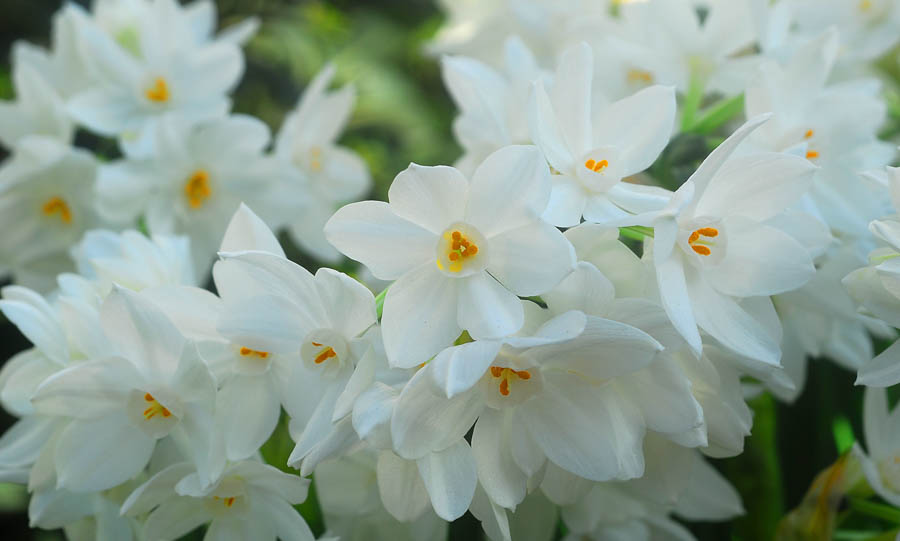Paperwhites for the California Holidays

GardenZeus receives commissions for purchases made through links in this post. There is no additional cost to you.
In comparison to the vibrant color of many indoor holiday plants, the white or white-yellow blooms of Paperwhites (Narcissus species) might seem plain, but when planted closely in pots to provide massed bloom, they provide a stunning compliment to the richer colors of Poinsettias and Amaryllis (see Indoor and Potted Plants for the Holiday Season). And unlike most other plants traditionally grown for indoor holiday display, Paperwhites can be planted outdoors in warm-winter California areas after holiday blooms are spent, where they naturalize and can bloom again year after year.
Paperwhites are native to the Mediterranean, which is similar in climate to much of California, with cool or cold rainy winters and warm-to-hot, dry summers. Unlike most Narcissuss species (such as Daffodils), winter chilling isn’t needed for Paperwhites to thrive and rebloom outdoors in warm-winter California gardens.
September through November is the time to plan ahead for indoor holiday flower displays. Paperwhites need about 4 to 6 weeks to bloom when grown indoors. Many options are available, including variable height, and more-fragrant versus less-fragrant varieties.
Are you too busy to tend indoor plants during the holidays? Vendors make it easy to grow Paperwhites, which are often sold already planted in pots or in kits that require almost no effort other than watering. Bulbs can also be grown in plain water, or in a glass vase or container with a decorative medium such as small polished stones, marbles, or sea glass, provided that water is changed every few days.
When grown indoors for holiday blooming, space bulbs closely, about 1 to 2 inches apart for a dense mass of blooms. Indoor holiday Paperwhites will bloom best and remain healthier in bright indoor light, preferably direct sunlight through a window for at least a few hours per day.
If you’re planning to plant Paperwhites outdoors after the holidays, deadhead to remove spent blooms. This prevents the bulbs from expending energy forming seed pods. Paperwhites are frost sensitive and best planted outdoors during warmer periods with daytime temperatures of at least 60° to 70°F. Plant bulbs in an area that receives at least a few hours of direct sunlight during winter, about 6 inches deep, and spaced at least several inches apart. Over years, bulbs will multiply, fill in, and may need to be dug up, separated, and replanted every few years to optimize blooming.
Top dress after planting with compost, and water to maintain moist soil during dry periods between winter rains. Bulbs will benefit from added phosphorus and potassium when soils are deficient or soil alkalinity is high.
Paperwhites may go dormant in response to mild frost, and may be killed by periods of hard frost. Sufficient sunlight and healthy leaf growth from winter through late spring or early summer will help bulbs to store energy for repeat blooming the following fall or winter. Like many California natives, Paperwhites have a dormant period during summer rather than winter, often beginning late spring or by midsummer in response to hot temperatures. Reduce to minimal and occasional watering as leaves die back and while Paperwhite are dormant until new leaf growth is seen from late summer through fall.
This is an updated version of an article originally published on November 21, 2019.
Other articles with holiday interest:
Gifts for Gardeners: Essential and Deluxe Tools for the Home Garden
Poinsettias: Tips, Care and Fun Facts for the Holidays
Indoor and Potted Plants for the Holiday Season
A Holiday Kiss Under the…Holly?: Mistletoe for The California Holidays, Part 1 of 3
A Holiday Kiss Under the…Tree-Killing Parasite?: Mistletoe for The California Holidays, Part 2 of 3